Get Rid Of Tomato Hornworms (Without Toxic Chemicals)
As an Amazon Associate and member of other affiliate programs, I earn from qualifying purchases.
Have you ever walked out to your garden one morning to find your tomato plants suddenly stripped bare of their leaves and flowers? If this scene sounds familiar to you, it’s not a rabbit or deer that has decimated your plants, it’s a tomato hornworm.
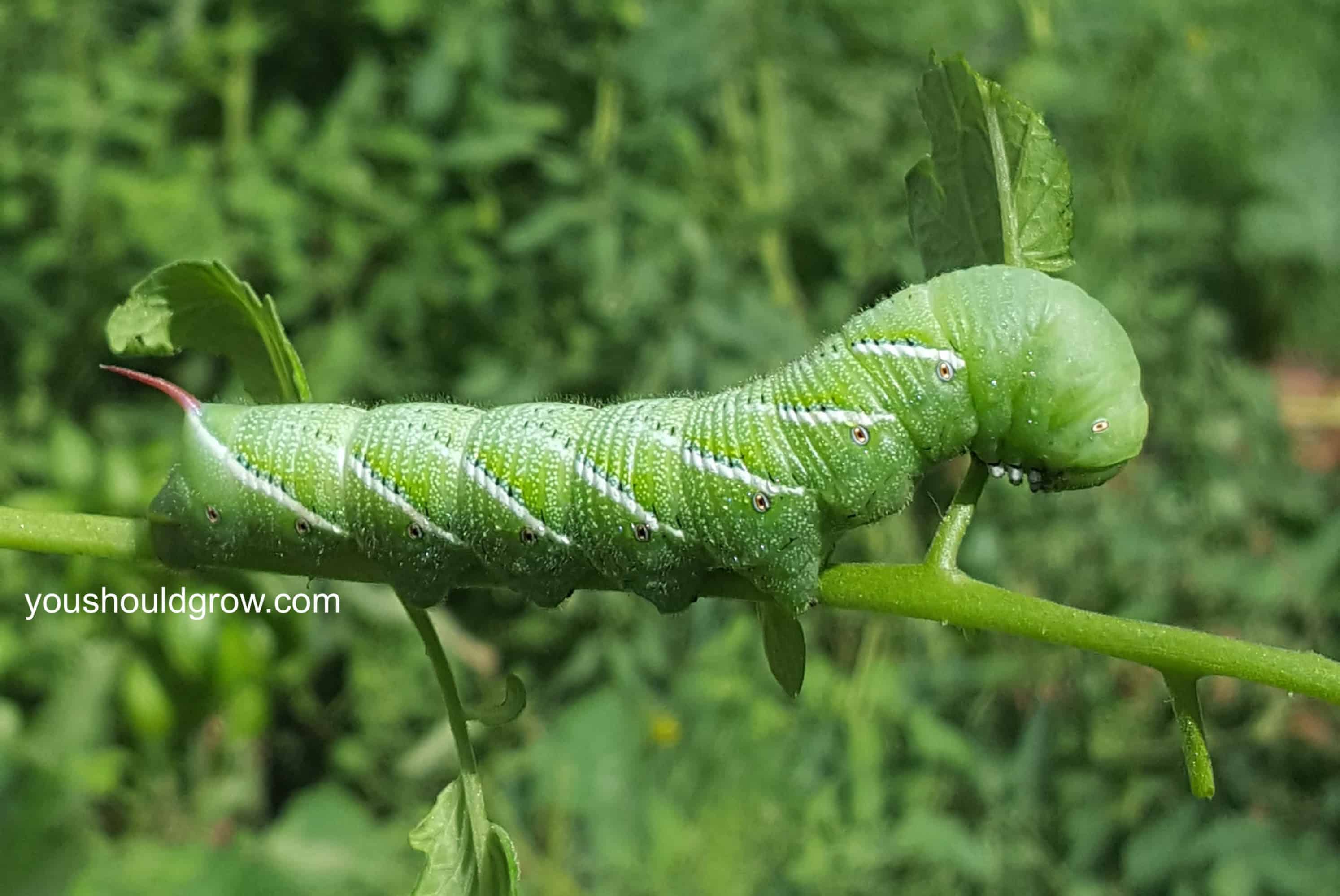
Tomato hornworms can strip a plant down to its bones overnight with their voracious appetites. It’s easy not to notice them too because their green flesh and stripes blend in perfectly with your healthy tomato plants.
In this post, we’ll be talking about what hornworms really are and when you need to take action to protect your plants.
What is a tomato hornworm?
Although we call them worms, tomato hornworms are actually caterpillars of the five-spotted hawk moth (Manduca quinquemaculata). And while the tomato hornworm is quite a pest in tomato gardens, the moth is a pretty cool creature also referred to as a sphinx moth or hummingbird moth.
Tomato hornworm moths are large, furry, brown to grey colored moths with a wingspan up to 8 inches! The moths tend to be active in the early evening feeding on nectar of several fragrant flowers.
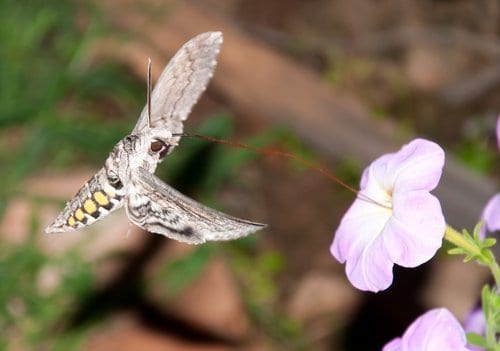
Their flight is similar to hummingbirds with their wings flapping quite rapidly as they dance from flower to flower. They also have an impressively long proboscis which makes them uniquely suited to feeding on trumpet-shaped flowers like honeysuckle.
For this reason, hawk moths have an important role as pollinators to flowers whose conformation makes it difficult for other pollinators to access.
Identifying tomato hornworms
There’s no confusing this green hornworm once you’ve seen one. Their green color matches tomato leaves exactly, and their light striping helps them blend right in. They have a horn that sticks up off their rear end, and a stubby green face with pointy claws for shoving food into their little mouths.
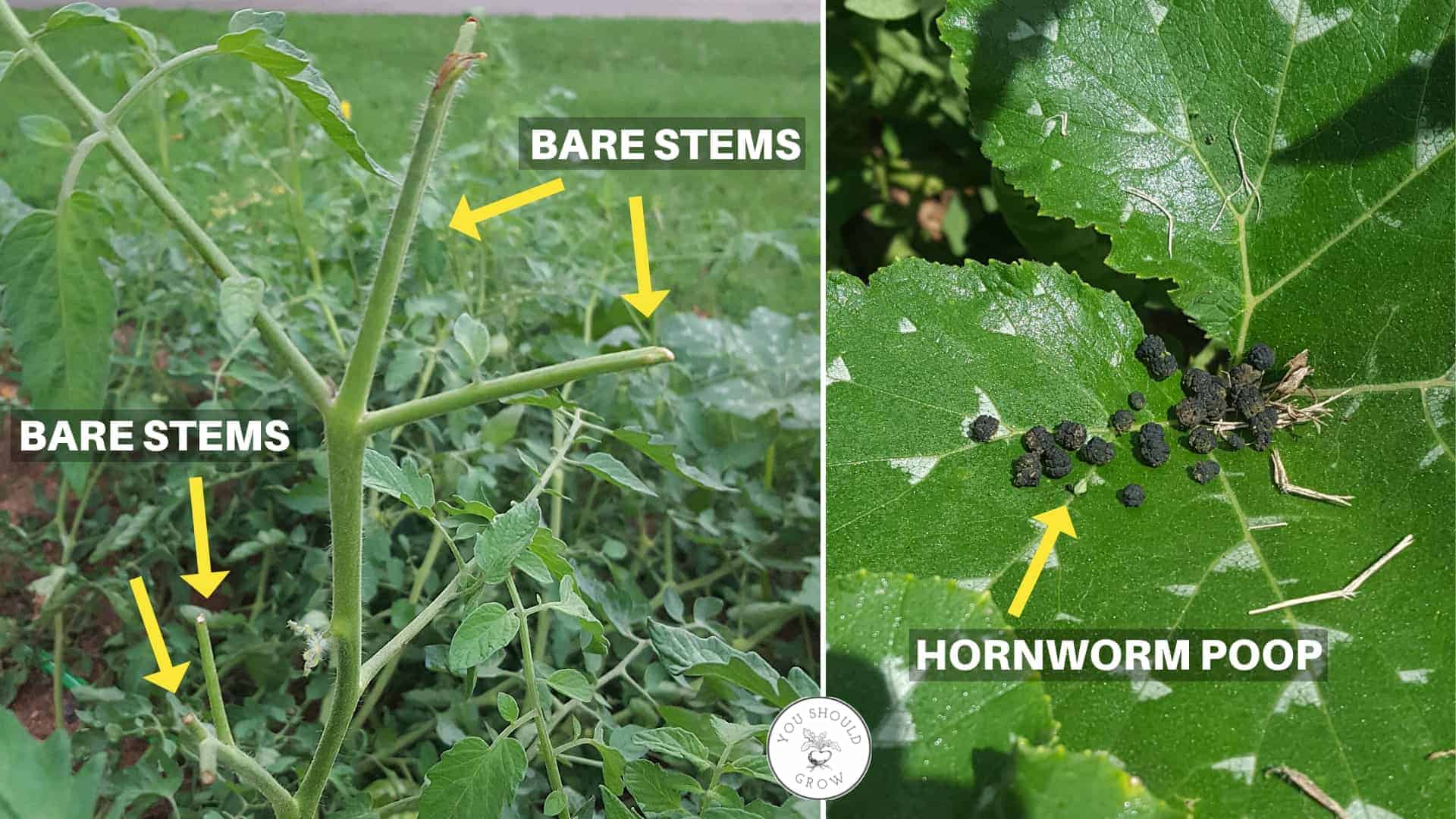
Besides the worms themselves, they leave behind some tell-tale evidence of their presence. Bare stems on your tomato plant and clusters of brown hornworm poop on the remaining leaves are clear signs that you’ve got hornworms.
They’ll also munch on your green fruit, so you should be checking for hornworms if you find un-ripe tomatoes with chewed out portions.
The smallest hornworm I’ve ever seen was about an inch long, but within a few weeks, they’ll grow to about a quarter inch wide and up to 5 inches long. As they grow in size, so does their appetite which explains how they can do so much damage.
Like the adult moth, these caterpillars are most active at night so it’s not uncommon to go out to visit your garden and find entire plants devoured overnight.
Tomato hornworm vs tobacco hornworm
To this point, I’ve been saying tomato hornworm, but in actuality what a lot of gardeners find on their tomato plants is technically a tobacco hornworm (Manduca sexta).
They’re easy to distinguish by their striping and color of their horn.
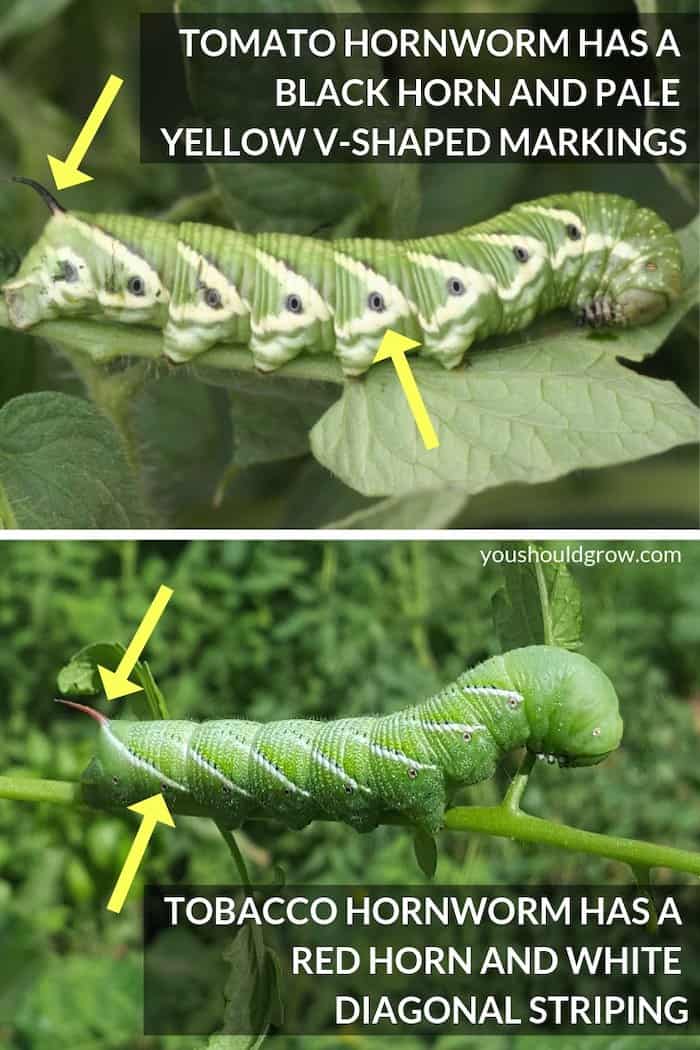
Tomato hornworms are more common in the north and have yellowish v-shaped stripes and a black horn. Tobacco hornworms are more prevalent in the south and have white diagonal striping and a red horn.
But it doesn’t matter whether it’s technically a tomato hornworm or a tobacco hornworm because they both cause the same amount of damage and should be controlled in the same way.
And, if you ask me, a hornworm eating your tomato plants is a tomato hornworm.
Tomato hornworm life cycle
Tomato hornworms are found across the United States and in parts of Mexico and Canada. In late spring and summer, fully grown hornworms burrow into the soil around your tomato plants where they pupate and overwinter in the soil around the base of your plants.
In the spring, hawk moths emerge from the pupa and mate. They lay their small, translucent green eggs on the undersides of leaves of tomato plants and other hosts. They tend to lay at the base of the leaves on the lowest portion of the plant.
If inadequate numbers of tomatoes are available, the moths will also lay on tobacco, potatoes, peppers, and eggplant.
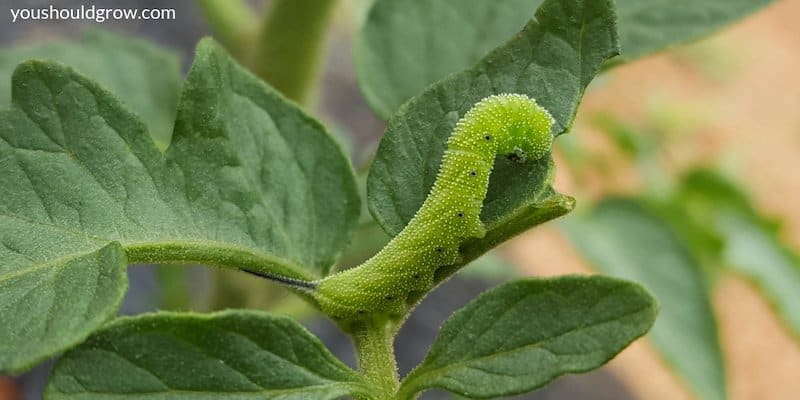
After a few days, the eggs hatch releasing small caterpillars who immediately begin munching on the leaves of your tomato plants. Within about 30 days, the caterpillar has finished growing at which point it will bury itself in the soil around the base of your plant to pupate.
If the weather doesn’t turn cold, the pupa will emerge as a new generation of moths within two weeks. So it’s easily possible that you’ll have two rounds of hornworms in one season if you leave them to their own devices.
Tomato hornworm control
Hand picking
When you find a hornworm caterpillar, the best thing you can do is pick it off your plant and step on it or feed it to your chickens. Hornworms can’t hurt you but they’re little legs are super grippy and can pinch a little.
If you find one hornworm, there are sure to be others so make sure to check your whole plant for more hornworms. And come back every day to check again.
In many instances, hand picking is an adequate method of controlling damage from hornworm problems. They’re not nearly as prolific as the armyworms in our garden, but if left unaddressed they can definitely ruin your tomato crop.
Plants that repel tomato hornworm
Companion planting with flowers to repel hornworms is worth a try. The flowers not only add color and beauty to your garden, but their odor can deter hornworm activity and attract insects that parasitize the hornworm.
Try planting borage, basil, marigolds, alyssum, or wildflowers with your tomato plants.
While planting flowers won’t completely prevent hornworms from munching on your tomato leaves, you will be attracting insects that prey on the hornworm eggs and larvae like ladybugs, lacewings, and predatory or parasitic wasp species.
If you find a hornworm with white eggs along its back, make sure to leave that one alone. The white eggs are actually wasp larvae that are feeding on the hornworm. Their presence indicates that you have a healthy insect population and the affected hornworm will die before it can damage your plants too much.
Organic pesticide options
Bt spray
One of the best options for hornworm control is the application of Bacillus thuringiensis, a bacteria that causes death in leaf-eating caterpillars. It’s one of the safest organic pesticides because it is completely safe to use around other insects. Only leaf-eating caterpillars are affected by the Bt.
To use Bt effectively you must be sure dilute it properly. Overly concentrated solutions can harm the leaves and fruit on your plants.
Because it is deactivated by sunlight and hornworms feed at night, it’s best to apply Bt in the evening. You’ll need to reapply Bt every 7-10 days starting in May or June.
Spinosad
Another organic option that works well for hornworms is the naturally derived pesticide spinosad. Spinosad is a natural substance made by bacteria that live in the soil.
It affects insects that eat or touch it by disrupting their nervous system leading to death in one to two days. Like Bt, Spinosad should be applied in the evening (sunlight affects is effectiveness) and reapplied every 7-10 days.
If you are having a lot of trouble with hornworms and other caterpillars, you might consider alternating Bt and spinosad treatments during the months that caterpillars are most active.
Be careful using spinosad around pollinators and other beneficial insects. If sprayed directly on them, it can affect them too. However, they should be safe to visit your plants after the product has dried.
Tomato hornworms as pets
Another option for dealing with hornworms is to keep one as a pet. This could be a great learning opportunity for your kids! They’re quite interesting little creatures to watch and the metamorphosis from caterpillar to hummingbird moth is pretty cool.
Here is a great resource for teaching about life cycles using the tomato hornworm.
Have you seen tomato hornworms in your garden?
Tell us about your experience in the comments below!


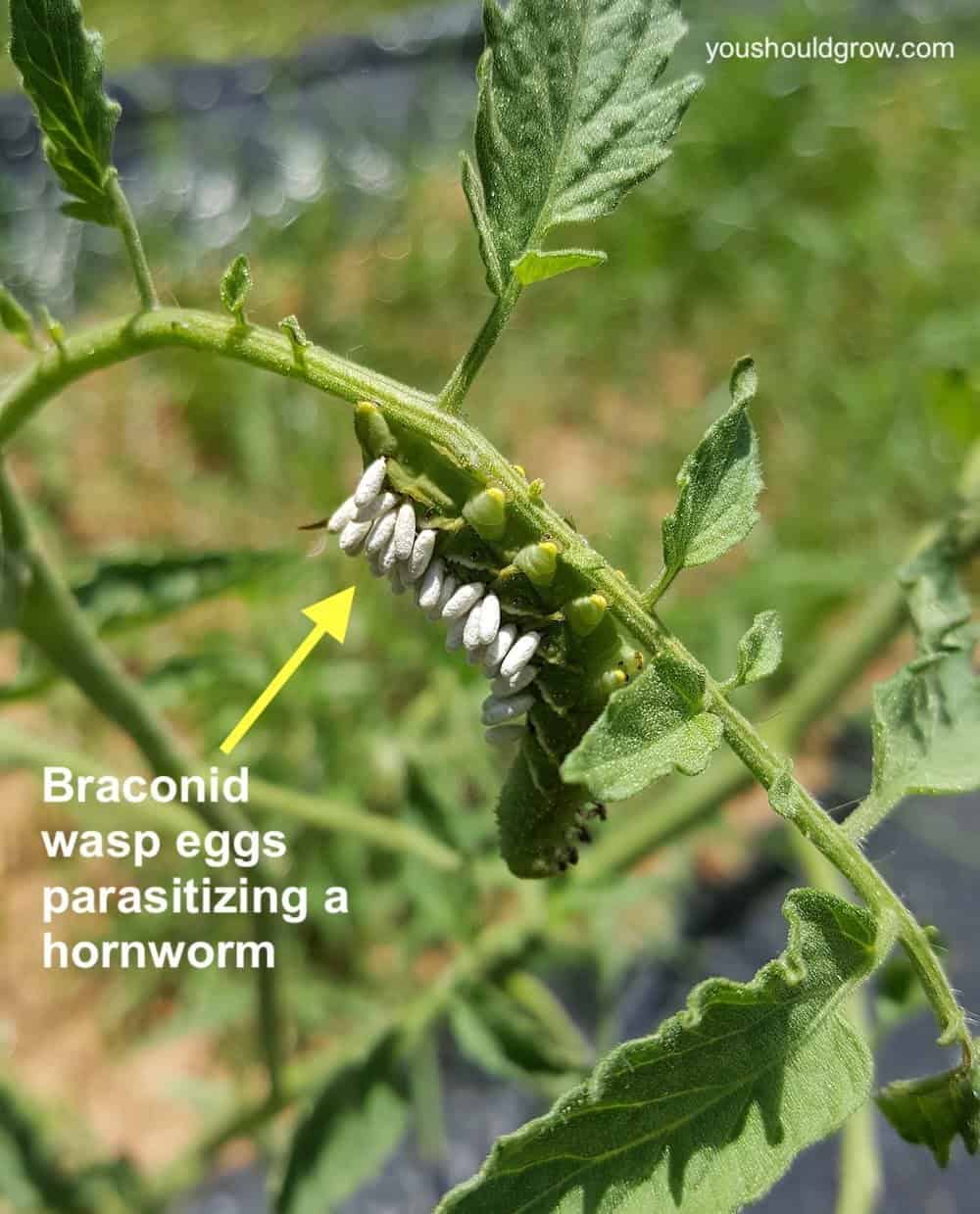
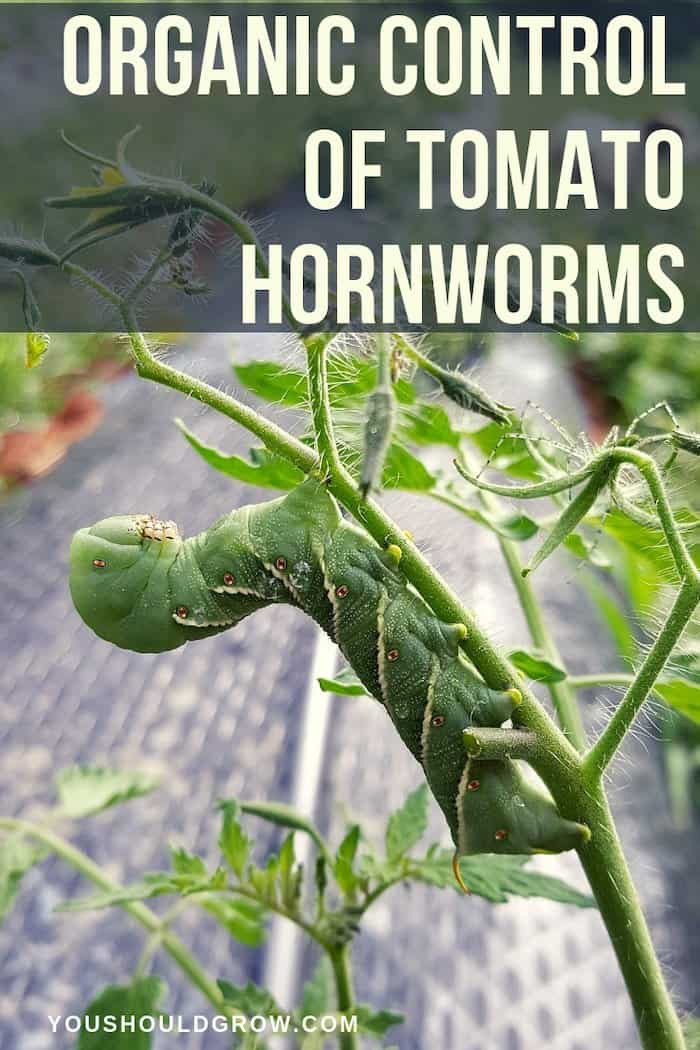






very informative and educational .
TQ
Ughh I have these critters. I’ve been pulling them off. Thanks for the info on the wasp .I thought they were baby worms….
Bob I thought the same thing. Glad I know now.
SINCE THE HORNWORMS HAVE PERFECT CAMOFLAGE ,LOOK FOR THEIR DROPPINGS ,THEN LOOK CLOSELY ON THE LEAVES ABOVE OR FRUIT THEY HAVE START TO DEVOUR . ALSO THE WHITE EGGCASES LAID BY THOSE WONDERFUL WASPS HELPS IMMENSELY IN YOUR SEARCH . THOSE WORMS ARE QUITE UNIQUE ,AND COLORFUL. BUT THEIR APPETITES ARE INSATIABLE .!! VERY GOOD ARTICLE FOR EVERYONE
I live on a lake, I pick them off my plants and put directly on a hook, bass love them! Mmm tried fish for dinner!
What are the ones that are bright yellow and black? Those are more common on my tomato plants. What are the best companion plants to help keep these pests away?
Those are yellow and black moth and butterfly caterpillars. Hard to say without a pic.
i use a mix of chewing tobacco brewed tea i use an old stocking lemon scent dish det. and lemon scent ammonia has to be lemon a little cheep antiseptic mouthwash and a little liquid fertilizer garden will smell great and won’t hurt plants
put in a spray bottle spray directly on worms
I just got some spinosad last night and the label says that it is toxic to bees for 3 hours after you apply, hence the recommendation to apply at night
Yes, mine went down in the soil to pupate about 2 weeks ago, and emerged today. I put them in a ‘critter’ carrier container so I could control which leaves they ate (the ones I provided for them, daily-or twice a day). When they quit eating and were crawling on the bottom of the container, I esearched and realized they needed soil. I gave them a mix of soils (didn’t know how heavy or damp a soil they wanted) in a deeper container and as soon as I left the room, and came back, they had already burrowed down. At first I gave them a pile of dirt, and I could see them through the bottom of the container, but they weren’t happy yet. After more research I found that they like to burrow 6-8 inches down, so I removed them and put 8 inches of soil in the container. They again disappeared (only after I had stepped out of the room-they sensed when I was watching). Seemingly, they found a happy space in there somewhere. They didn’t seem to want to be near where the light was, so I didn’t get to watch them pupate.
Whoa! This was very good info! As I was reading it we found another one! Now I know why lol
Now we are on to find an essential oil to tackle these weird looking beasts!🤣 🐛
The insecticide “Neam” works very well on tomato hornworms. It is natural and non-toxic.
Let’s all destroy everything we don’t love. Let’s kill all things if they slightly interfere with OUR plan. I pick off the caterpillars and relocate them to a weak plant that I can lose. It’s purely stupid to do anything else.